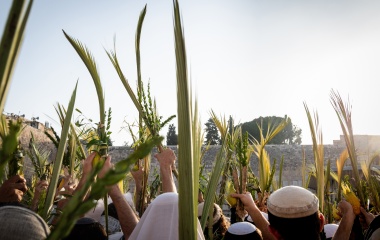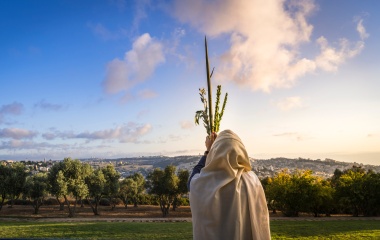
It is hard to imagine a more impactful ritual than that of our weekly Torah reading. While its origins date to Moshe Rabbeinu—acting in his capacity as a rabbinic sage, not as prophet delivering G-d's message—and Ezra the scribe, it was not until the Middle Ages that our annual Torah reading cycle was firmly established. It is through the prism of the weekly Torah reading that Jewish life operates. I shudder to think what would happen to our knowledge of the Bible if not for parshat hashavua; one need only examine how well versed we are in the rest of Tanach to get an inkling.
While the weekly Torah reading follows a set cycle, the Torah reading selected by our Sages to be read on holidays reflect the themes of the day. We read, for example, about the Exodus on Pesach and the receiving of the Torah on Shavuot.
Yet the reason for the reading chosen by our Sages for Shabbat Chol Hamoed—both on Pesach and Sukkot—is far from obvious. Taken from parshat Ki-Tissa, it focuses on the aftermath of the sin of the golden calf. While the last few verses make mention of the three pilgrim festivals, it is those verses that seem out of context in relation to the main theme of the reading.
It is on the Yamim Tovim that we celebrate the relationship between G-d and the Jewish people. We were formed as a nation on Pesach and received our raison d'être on Shavuot. Rosh Hashanah and Yom Kippur are opportunities to renew our relationship with G-d, followed by Sukkot when we celebrate G-d's protective canopy hovering above us. Shmini Atzeret celebrates the special relationship between G-d and the Jewish people as we head into the long winter months.
While Shabbat is rooted in nature, Yom Tov is rooted in history. This notion is reflected by the fact that Shabbat occurs like clockwork every seven days, whereas Yom Tov is dependent on—and determined by—the Jewish people sanctifying the moon. It is we who tell G-d when to sit in judgment by determining when Rosh Hashanah falls out; and we have declared that such judgment cannot take place on a Sunday, Wednesday, or Friday, known in rabbinic parlance as lo adu rosh.
It is man who determines the start of Yom Tov, just as man determines much of the unfolding of history. It is on Yom Tov that we must “rejoice in the festival", and that same mitzvah of simcha, joy, demands that we go to Jerusalem, where G-d's presence is most readily felt. It is at the Temple where fear of G-d and joy in being in His presence merge. Yet for many, this merger is most difficult. Often, we seek G-d in inappropriate (even if well-meaning) ways.
The Jewish people were on a spiritual high; having left Egypt, defeated Amalek, seen food fall from heaven, and heard—nay, saw (see Shemot 20:15)—the all-too-powerful voice of G-d at Sinai. They wanted G-d right in their midst. When Moshe, who in their eyes represented G-d, went “missing” they demanded of Aharon, “Rise up and make for us a god” (Shemot 32:1). What a noble if misplaced sentiment. “They arose the next day and sacrificed burnt offerings and brought peace offerings” (Shemot 32:5)—offerings we are commanded to bring on the festivals—“and the people sat down to eat and drink”—activities we are commanded to do on the festivals.
Yet while their desire for closeness to G-d is to be commended, their method is not. The G-d of Israel demands that something as powerful as the worship of the Creator of the Universe be done in a particular fashion. The minute details of Jewish law teach that it is not enough to seek G-d; rather, we must do so in a prescribed fashion. There is much room for personal manifestation of spirituality, but there are red lines we dare not cross. Even—perhaps especially—the righteous amongst us need to be mindful of this. This is a point most strikingly brought home with the death of two of Aaron's sons, Nadav and Avihu, for bringing an “eish zara, a foreign fire, to G-d” (Vayikra 10:1). The term zara should make us shudder, with avodah zara the biblical word for idolatry. The line between avodat Hashem and avodah zara is often thin indeed. One can mean well, even be righteous, and yet offer an avodah to Hashem that is zara.
On Shabbat Chol Hamoed we read how G-d forgave the Jewish people for the chet haegel, for the sin of avodah zara. G-d was ready to destroy the Jewish people. Instead, He renewed His relationship with us and Yom Kippur became a day of teshuva, a day G-d yearns for us to return to Him. "You give Your hand to sinners and Your right [hand] is extended to receive those who return" (Neilah of Yom Kippur). It is the day of Lifnei Hashem Teetharu (Vayikra 16:30), that we purify ourselves in the presence of G-d, no matter how far we may have distanced ourselves from Him. Given the opportunity to renew our relationship with G-d, we "rejoice for seven days in the presence of G-d" as we dwell in our sukkot.
While Pesach is rooted in the past, Sukkot is rooted in the future; "so that your generations shall know" (Vayikra 23:43). The Haftarot of Sukkot focus on the messianic era and redemption. The holiday of Sukkot, unlike our other holidays, does not commemorate a particular historical event. Rather, it is a celebration of journey, a long journey to the land "that G-d has chosen", a journey to feel the protective embrace of G-d. It is the journey that takes a lifetime and then some. We may not reach the final destination, but a journey taken in purity brings great joy, the joy of drawing closer to G-d.



